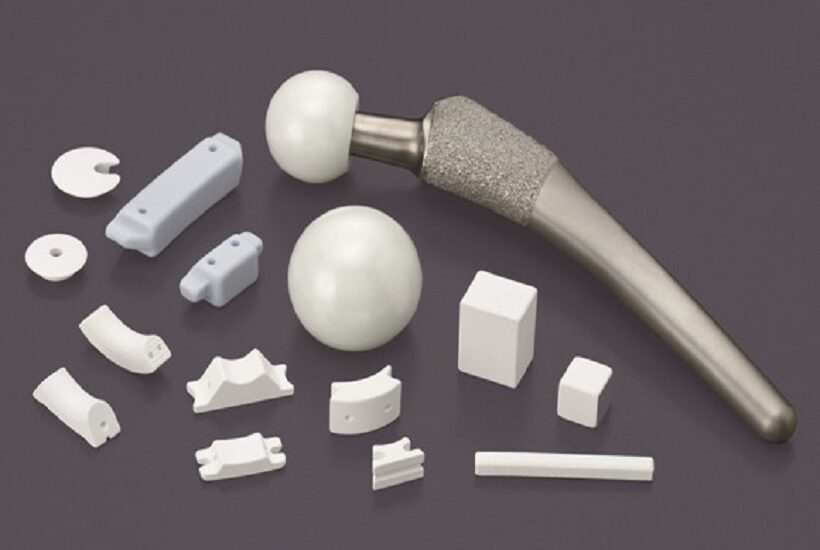The bioceramics and hydroxyapatite market is expected to exhibit a robust 6.9% CAGR during the forecasted period (2022-2028), with a positive long-term outlook. Aluminium oxide is projected to maintain its dominance, constituting approximately 45% of the global market. Hydroxyapatite, known for its exceptional mechanical strength and biocompatibility, is expected to remain a favored material for orthopedic implants. Dental implants, especially those using zirconia-based bioceramics, are poised to retain a significant market share within the bioceramics and hydroxyapatite industry.
Healthcare firms are interested in hydroxyapatite because it interacts with the body’s living tissues to deliver efficient bone development solutions. The increasing use of hydroxyapatite in the healthcare sector has broadened the potential of market expansion for the global bioceramics and hydroxyapatite market. In 2017, the market for hydroxyapatite and bioceramics increased by 5.7% year on year. By the end of 2022, the global market for bioceramics and hydroxyapatite is expected to reach US$ 3 billion. North America and Europe are expected to hold roughly 60% of the global market for bioceramics and hydroxyapatite by the end of 2018, and demand for these materials is expected to grow moderately due to their use in dental and orthopaedic implants, among other applications.
Request Copy of Sample Report: https://www.futuremarketinsights.com/reports/sample/rep-gb-7049
Bioceramics, also known as medical ceramics, are significant components in the manufacture of dental and orthopedic implants. Bioceramics materials are typically made of oxides, carbides, or nitrides. Bioceramics are still popular, and depending on the material type, they can be classified as biologically active, inert, or resorbable. Aluminum oxide, zirconia, calcium phosphate (tricalcium phosphate, hydroxyapatite), and bioglass are among the most widely utilized bioceramics in a variety of industries. Hydroxyapatite is a calcium phosphate bioceramic that is naturally biologically active. Natural human bone is composed of 70% hydroxyapatite. As a result, it has great biocompatibility. Hydroxyapatite also improves bone health and bone development. However, the low mechanical strength of hydroxyapatite has limited its applicability.
Growing need for developing effective dental implants, hip, joints, and knee replacement devices are projected to fuel demand for bioceramics and hydroxyapatite over the forecast period. Production of implants per capita has further translated to an exponential market growth over the past decade.
There has been increase in percentage of ageing population which are prone to greater risk of diseases such as osteoarthritis, knee , joint and hip problems, tooth decay amongst others. Ageing population coupled with other factors such as increasing number of accidents, bad eating habits leading to tooth decay amongst others is projected to drive the demand for bioceramics and hydroxyapatite over the forecast period.
Attributed to enhanced biocompatibility, high mechanical strength, and chemical and thermal stability, bioceramics and hydroxyapatite are increasingly being used for orthopaedic and dental implants. Growing health concerns pertaining to the impact of the materials used for developing dental implants has led manufacturers to direct their investments towards utilizing titanium as an important component. However, lack of maintenance of titanium implants can result in corrosion of the implants. To offer improved patient care, the manufacturers are developing zirconia-based implants that are white colored ceramic material. These implants offer improved biocompatibility and are likely to encourage demand for bioceramics and hydroxyapatite in the healthcare industry.
Contrary to the factors boosting the market growth, availability of bioceramics and hydroxyapatite at premium prices and lack of awareness among consumers is likely to inhibit growth of the global bioceramics and hydroxyapatite market over the coming years. Also, lack of technological advancements in developing countries of Asia Pacific region there has been still been prevalence of metal-based implants which may hinder the bioceramics and hydroxyapatite market growth in the long run.
Ask Us Your Questions About This Report: https://www.futuremarketinsights.com/ask-question/rep-gb-7049
Segmentation Analysis
- On the basis of material type, the aluminium oxide segment is projected to retain its dominance in the global bioceramics and hydroxyapatite market throughout the forecast period, accounting for a value share of ~45% by the end 2018.
- On the basis of type, bio-inert is expected to remain a leading segment in the global bioceramics and hydroxyapatite market, recording a CAGR of 6.8% over the forecast period. However, the bio-active segment is expected to witness higher growth rate in terms of value.
- On the basis of application, sales of the bioceramics and hydroxyapatite is likely to remain concentrated for the development of the orthopaedic implants. However, other applications such as dental implants and implantable electronic devices are projected to witness significant growth over the coming years in terms of consumption.
Vendor Insights
The report highlights some of the top companies operating in the global bioceramics and hydroxyapatite market, which include Morgan Technical Ceramics, CeramTec, Berkeley Advanced Biomaterials, Inc., Kyocera Corporation, Cam Bio Ceramics BV, FLUIDINOVA, Premier Biomaterials, Plasma Biotal Ltd., SofSera, Bonesupport AB, Nano Interface Technology, and Sigma Graft amongst others.
Key Segmentation
By Material Type
- Aluminium Oxide
- Zirconia
- Calcium Phosphate
By Type
- Bio-Inert
- Bio-Active
- Bio-Resorbable
By Application
- Dental Implants
- Orthopaedic Implants
By Region
- North America
- Latin America
- Eastern Europe
- Western Europe
- SEA and Pacific
- China
- India
- Japan
- MEA
About Future Market Insights (FMI)
Future Market Insights, Inc. (ESOMAR certified, recipient of the Stevie Award, and a member of the Greater New York Chamber of Commerce) offers profound insights into the driving factors that are boosting demand in the market. FMI stands as the leading global provider of market intelligence, advisory services, consulting, and events for the Packaging, Food and Beverage, Consumer Technology, Healthcare, Industrial, and Chemicals markets. With a vast team of over 5000 analysts worldwide, FMI provides global, regional, and local expertise on diverse domains and industry trends across more than 110 countries.
Contact Us:
Future Market Insights Inc.
Christiana Corporate, 200 Continental Drive,
Suite 401, Newark, Delaware – 19713, USA
T: +1-845-579-5705
For Sales Enquiries: sales@futuremarketinsights.com
Website: https://www.futuremarketinsights.com
LinkedIn| Twitter| Blogs | YouTube

